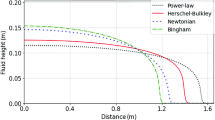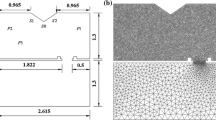Abstract
Owing to its ability of modelling large deformations and the ease of dealing with moving boundary conditions, the material point method is gaining popularity in geotechnical engineering applications. In this paper, this promising Lagrangian method is applied to hydrodynamic problems to further explore its potential. The collapse of water columns with different initial aspect ratios is simulated by the material point method. In order to test the accuracy and stability of the material point method, simulations are first validated using experimental data and results of mature numerical models. Then, the model is used to ascertain the critical aspect ratio for the widely-used shallow water equations to give satisfactory approximation. From the comparisons between the simulations based on the material point method and the shallow water equations, the critical aspect ratio for the suitable use of the shallow water equations is found to be 1.
Similar content being viewed by others
References
Brackbill J. U., Kothe D. B., Ruppel H. M. FLIP: A lowdissipation, particle-in-cell method for fluid flow [J]. Computer Physics Communications, 1988, 48(1): 25–38.
Sulsky D., Zhou S. J., Schreyer H. L. Application of a particle-in-cell method to solid mechanics [J]. Computer Physics Communications, 1995, 87(1–2): 236–252.
Sulsky D., Chen Z., Schreyer H. L. A particle method for history-dependent materials [J]. Computer Methods in Applied Mechanics and Engineering, 1994, 118(1–2): 179–196.
Bardenhagen S. G., Kober E. M. The generalized interpolation material point method [J]. Computer Modeling in Engineering and Sciences, 2004, 5(6): 477–495.
Zhang H. W., Wang K. P., Chen Z. Material point method for dynamic analysis of saturated porous media under external contact/impact of solid bodies [J]. Computer Methods in Applied Mechanics and Engineering, 2009, 198(17–20): 1456–1472.
Alonso E. E., Zabala F. Progressive failure of Aznalcóllar dam using the material point method [J]. Géotechnique, 2011, 61(9): 795–808.
Jassim I., Stolle D., Vermeer P. Two-phase dynamic analysis by material point method [J]. International Journal for Numerical and Analytical Methods in Geomechanics, 2013, 37(15): 2502–2522.
Abe K., Soga K., Bandara S. Material point method for coupled hydromechanical problems [J]. Journal of Geotechnical Engineering, 2013, 140(3): 04013033.
Bandara S., Soga K. Coupling of soil deformation and pore fluid flow using material point method [J]. Computers and Geotechnics, 2015, 63: 199–214.
Zhao X., Liang D. MPM Modelling of seepage flow through embankments [C]. 26th International Ocean and Polar Engineering Conference. Rhodes, Greece, 2016, 1161–1165.
Ma S., Zhang X., Qiu X. M. Comparison study of MPM and SPH in modeling hypervelocity impact problems [J]. International Journal of Impact Engineering, 2009, 36(2): 272–282.
Liang D. Evaluating shallow water assumptions in dambreak flows [J]. Proceedings of the Institution of Civil Engineers Water Management, 2010, 163(5): 227–237.
Shao S., Lo E. Y. M. Incompressible SPH method for simulating Newtonian and non-Newtonian flows with a free surface [J]. Advances in Water Resources, 2003, 26(7): 787–800.
Liang D., Falconer R. A., Lin B. Improved numerical modelling of estuarine flows [J]. Proceedings of the Institution of Civil Engineers-Maritime Engineering, 2006, 159(1): 25–35.
Fraccarollo L., Toro E. F. Experimental and numerical assessment of the shallow water model for two-dimensional dam-break type problems [J]. Journal of Hydraulic Research, 1995, 33(6): 843–864.
Liang D., Lin B., Falconer R. A. A boundary-fitted numerical model for flood routing with shock-capturing capability [J]. Journal of Hydrology, 2007, 332(3–4): 477–486.
Liang D., Lin B., Falconer R. A. Simulation of rapidly varying flow using an efficient TVD-MacCormack scheme [J]. International Journal for Numerical Methods in Fluids, 2007, 53(5): 811–826.
Martin J. C., Moyce W. J. An experimtal study of the collapse of liquid columns on a rigid horizontal plane [J]. Philosophical Transactions of the Royal Society of London. Series A, 1952, 244(88): 312–324.
Hirt C. W., Nichols B. D. Volume of fluid (VOF) method for the dynamics of free boundaries [J]. Journal of Computational Physics, 1981, 39(1): 201–225.
Author information
Authors and Affiliations
Corresponding author
Additional information
Biography: Xuanyu Zhao, Male, Ph. D. Candidate
Rights and permissions
About this article
Cite this article
Zhao, X., Liang, D. & Martinelli, M. MPM simulations of dam-break floods. J Hydrodyn 29, 397–404 (2017). https://doi.org/10.1016/S1001-6058(16)60749-7
Received:
Revised:
Published:
Issue Date:
DOI: https://doi.org/10.1016/S1001-6058(16)60749-7




